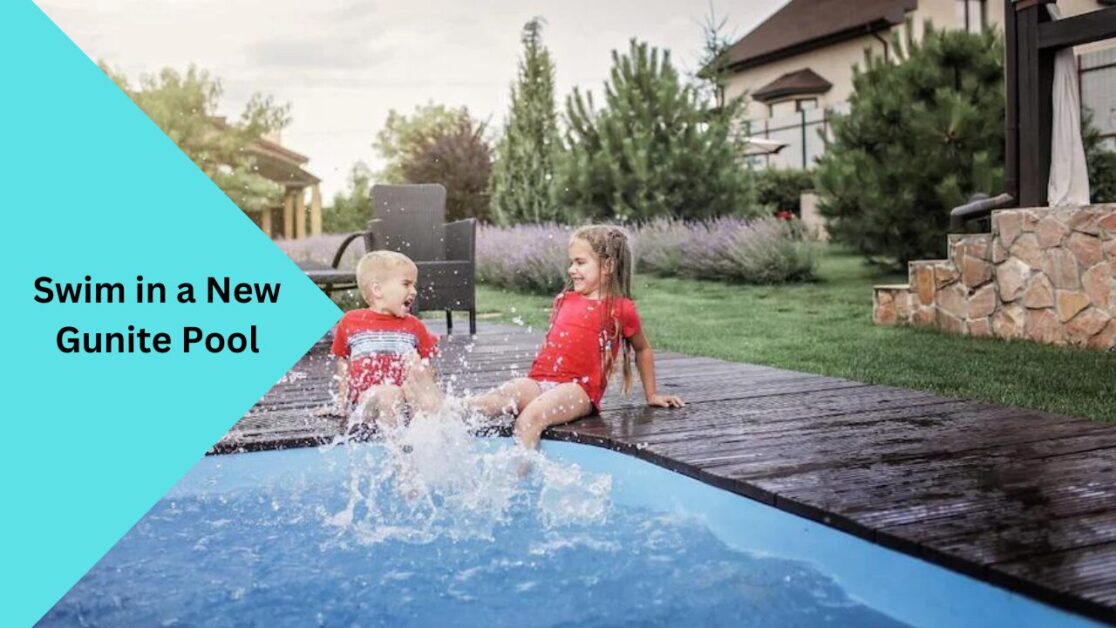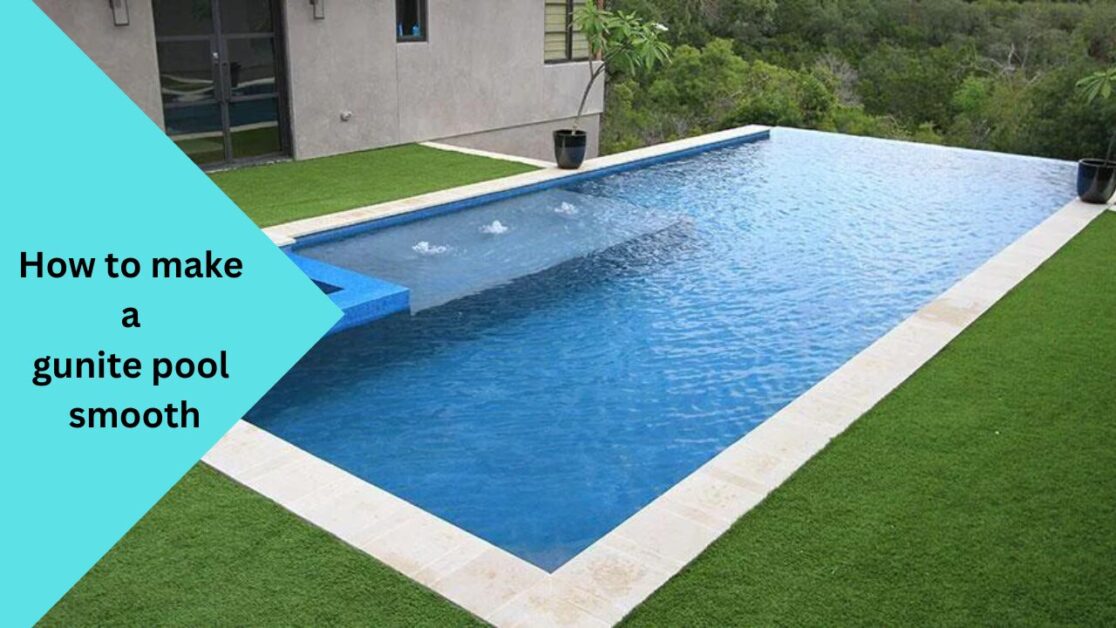Imagine stepping into your backyard and dipping your toes into crystal-clear water that sparkles in the sunlight. A gunite pool not only adds elegance to your home but provides a refreshing oasis on hot summer days. However, over time, your once smooth and flawless pool may start to show signs of wear and tear. In this comprehensive guide, we will explore everything you need to know about keeping your gunite pool smooth and luxurious. From regular maintenance and troubleshooting to resurfacing techniques and extending the pool’s lifespan, we’ve got you covered. So, let’s dive in and discover how to make a gunite pool smooth for endless enjoyment.
Understanding Gunite Pools
First, let’s start by understanding what exactly a gunite pool is and why it’s a popular choice among homeowners.
What is a Gunite Pool?
A gunite pool is a type of swimming pool constructed by spraying a mixture of cement, sand, and water onto a reinforced framework. The combination of these materials creates a highly durable structure that can withstand the test of time.
Gunite pools are known for their versatility as they can be built in various shapes and sizes, allowing you to customize it to your desired design. These pools also offer flexibility in terms of depth, making it suitable for both recreational swimmers and diving enthusiasts.
The Benefits of Owning a Gunite Pool
There are several advantages to owning a gunite pool, making it a popular choice among homeowners:
- Durability: Gunite pools are built to last, thanks to their solid construction and reinforced framework. With proper maintenance, a gunite pool can offer enjoyment for decades.
- Customization: Unlike pre-made fiberglass or vinyl pools, gunite pools can be tailored to fit your unique preferences. From freeform shapes to luxurious finishes, you have the flexibility to create the pool of your dreams.
- Visual Appeal: Gunite pools provide a high-end and visually stunning addition to any property. Whether you prefer a classic design or a contemporary style, the versatility of gunite pools allows you to achieve the aesthetic you desire.
- Resale Value: Installing a gunite pool can significantly enhance the value of your home. Potential buyers are often drawn to the luxurious appeal and durability of gunite pools, making it a worthwhile investment.
Now that we have a better understanding of gunite pools, let’s move on to the crucial aspects of maintaining your pool to keep it in pristine condition.To explore more details and considerations regardingBenifit of Gunite Pool, our comprehensive guide on Exploring Gunite Pools: Pros and Cons has you covered.
Maintaining Your Gunite Pool
Proper maintenance is essential to preserve the smoothness of your gunite pool and ensure it remains a safe and enjoyable environment for swimmers. Here are some key practices to keep in mind:
Regular Cleaning and Chemical Balance
Regular cleaning and maintaining the correct chemical balance in your pool are fundamental to prevent issues such as algae growth, stains, and scale buildup. Follow these practices for optimal maintenance:
- Skim the surface and use a pool vacuum to remove debris.
- Brush the walls and floor to prevent algae growth and remove any accumulated dirt or stains.
- Clean the pool filter regularly to ensure efficient circulation and filtration.
- Test and balance the pool’s pH, chlorine, alkalinity, and calcium hardness levels according to manufacturer guidelines.
- Shock the pool occasionally to eliminate contaminants and maintain water clarity.
By adhering to a regular cleaning and maintenance routine, you can prolong the lifespan of your gunite pool and avoid potential problems.To explore more details and considerations regarding Maintain, our comprehensive guide on How to Maintain a Gunite Pool ? has you covered.
Troubleshooting Common Issues
Even with regular maintenance, gunite pools may encounter common issues that require troubleshooting. Here are some common problems and their solutions:
- Cracks: Cracks in the pool’s surface can occur over time due to shifts in the ground or structural stress. Address small cracks promptly using pool-grade epoxy putty or consult a professional for larger cracks.
- Stains: Stains can be a result of organic matter, metal deposits, or chemical imbalances. Identify the type of stain and apply the appropriate treatment, such as a stain-removing solution or metal sequestrant.
- Rough Surfaces: Despite proper maintenance, gunite pool surfaces may become rough over time. This can be caused by mineral deposits or the age of the surface. In the following section, we will delve into a more extensive solution for achieving a smooth finish.
By troubleshooting these issues promptly, you can maintain the overall smoothness and appearance of your gunite pool. However, if the problems persist or your pool requires a more extensive transformation, it may be time to consider resurfacing.
Resurfacing a Gunite Pool
Resurfacing your gunite pool is a comprehensive solution to restore its smoothness and revitalize its appearance. Let’s explore the steps involved in resurfacing a gunite pool:
Signs That Your Pool Needs Resurfacing
Over time, gunite pools can develop visible signs of wear and tear, indicating the need for resurfacing. Keep an eye out for the following signs:
- Rough or Uneven Surface: If the once-smooth surface of your pool becomes rough or uneven, it may be time for resurfacing. A degraded surface not only compromises the pool’s aesthetics but can also be uncomfortable for swimmers.
- Excessive Stains or Discoloration: Stubborn stains or deep discoloration that cannot be removed through regular cleaning may indicate the need for resurfacing. This is especially true if the stains penetrate the surface or affect a large area.
- Cracks and Structural Issues: While small cracks can often be repaired, larger cracks or structural issues are signs that resurfacing may be necessary. Prompt action can prevent further damage and maintain the pool’s integrity.
If you notice any of these signs, consult with a professional pool contractor to assess the condition of your pool and determine if resurfacing is required.
Preparing Your Pool for Resurfacing
Before beginning the resurfacing process, you need to adequately prepare your pool. Follow these steps to ensure a smooth and successful resurfacing project:
- Drain the Pool: Completely drain the pool, taking care to follow local regulations for proper water disposal.
- Remove Fixtures and Accessories: Remove any removable fixtures or accessories, such as ladders, handrails, or skimmer baskets. This will provide easy access for the resurfacing process.
- Clean and Scrape the Surface: Thoroughly clean the pool’s surface, removing any remaining dirt, algae, or loose debris. Use a scraper to remove any loose or flaking material to create a smooth base.
- Repair Cracks and Damage: Assess the pool’s surface for cracks or structural damage. Address any necessary repairs before proceeding with resurfacing.
By following these preparation steps, you create a solid foundation for the resurfacing process, ensuring the new surface adheres properly and delivers a seamless finish.
The Resurfacing Process Explained
The resurfacing process involves applying a new layer of material to the gunite pool, rejuvenating its appearance and smoothness. Here’s an overview of the typical resurfacing process:
- Priming and Bonding Coat: The pool surface is prepared by applying a bonding coat that improves adhesion between the existing surface and the new material.
- Applying the New Material: A specialized mixture, such as a quartz-based or pebble-based finish, is applied evenly to the pool surface using various techniques, such as spraying or troweling. This layer provides the smooth and luxurious finish.
- Curing and Finishing Touches: After the new material is applied, it requires time to cure and set properly. The pool will be filled with water, and the resurfaced surface may undergo additional finishing touches to ensure a flawless result.
Resurfacing a gunite pool is a complex process that requires specialized knowledge and expertise. Consider hiring a professional pool contractor experienced in resurfacing to achieve the best results. They can guide you through material selection and application techniques to ensure a smooth and durable finish.
As you begin the resurfacing process, you may wonder about the ideal time frame for enjoying your revived pool. Let’s take a look at how soon you can swim in a freshly resurfaced gunite pool.
How Soon Can You Swim in a New Gunite Pool?

After resurfacing your gunite pool, it’s crucial to allow sufficient time for the new surface to cure and set. The specific timeline can vary depending on factors such as the type of material used and weather conditions. However, as a general guideline, it’s recommended to wait approximately 7 to 10 days before swimming in a newly resurfaced pool. This ensures the surface has properly hardened and minimizes the risk of damage or premature wear.To explore more details and considerations regarding Build pool, our comprehensive guide on How Long Does It Take to Build Gunite Pool: A Comprehensive Guide has you covered.
While waiting for the curing period to end, use this time to plan and prepare for the grand reopening of your rejuvenated pool oasis. Next, let’s explore some tips to help you achieve a flawlessly smooth finish on your gunite pool.
Achieving a Smooth Finish
A smooth and visually appealing pool surface enhances the overall swimming experience and contributes to the pool’s aesthetics. Here are some tips to help you achieve a flawlessly smooth finish on your gunite pool:
How to Smooth Out Imperfections
If you notice minor imperfections or rough spots on your pool’s surface, there are techniques you can employ to address them:
- Hand Sanding: For smaller areas, use sandpaper or a sanding block to gently smooth out rough spots or imperfections.
- Acid Washing: A mild acid wash can be used to remove stubborn stains and mineral deposits that affect the smoothness of the pool surface. However, it’s important to use caution and follow all safety instructions when performing acid washing.
- Professional Grinding and Polishing: For more extensive imperfections or roughness, consider hiring a professional pool contractor skilled in grinding and polishing techniques. They can restore the smoothness of your pool surface effectively and efficiently.
By taking these steps, you can improve the surface smoothness of your gunite pool, ensuring a luxurious and enjoyable swimming experience.
Selecting the Right Material for a Smooth Finish
When it comes to resurfacing your gunite pool, selecting the right material is paramount in achieving a smooth and visually appealing finish. Here are several popular options to consider:
- Quartz-based Finishes: Quartz finishes consist of a mixture of quartz, cement, and additives, providing a durable and smooth surface. The tiny quartz particles contribute to the smoothness and enhance the pool’s appearance.
- Pebble-based Finishes: Pebble finishes incorporate natural pebbles or aggregates into the material mixture, resulting in an attractive and textured surface. While it may have a slightly more rustic texture, pebble finishes can still offer a remarkably smooth swimming experience.
- Plaster Finishes: Plaster is a traditional and budget-friendly option for resurfacing a gunite pool. While it may not deliver the same level of smoothness as quartz or pebble finishes, proper application and maintenance can still provide a satisfactory swimming experience.
When selecting the right material, consider factors such as budget, desired aesthetics, and durability. Consult with a pool professional who can provide guidance based on your specific needs and preferences.
Professional vs. DIY: Pros and Cons
Resurfacing a gunite pool can be a significant undertaking, and you may wonder whether to tackle it as a DIY project or hire a professional. Let’s explore the pros and cons of each approach:
Hiring a Professional:
Pros:
- Experience and Expertise: Pool professionals have the necessary knowledge and expertise to ensure a smooth and successful resurfacing process.
- Time and Labor: Resurfacing is a labor-intensive project that can be time-consuming. Hiring professionals saves you the hassle while providing efficient and precise results.
- Quality Guarantee: Reputable pool contractors often offer warranties or guarantees on their workmanship and materials, providing peace of mind.
Cons:
- Cost: Hiring professionals can be more expensive upfront compared to a DIY approach. However, the investment may be justified by the quality of work and the lasting results.
DIY Approach:
Pros:
- Cost Savings: Undertaking the project yourself can save money on labor costs.
- Personal Involvement: Completing the project on your own can be a satisfying and rewarding experience, giving you a sense of accomplishment.
Cons:
- Risk of Mistakes: Resurfacing requires specialized knowledge and techniques. Without professional guidance, there is a higher risk of making mistakes that could affect the quality and longevity of the resurfacing job.
- Time and Effort: DIY resurfacing projects can be time-consuming and physically demanding, especially for individuals with limited experience or skills.
Consider your personal skills, available time, and the complexity of the project when deciding between a professional or DIY approach. Consulting with a pool professional can help you make an informed decision best suited to your needs.
Extending the Lifespan of Your Gunite Pool
Now that you’ve invested in resurfacing your gunite pool and achieved a smooth finish, it’s time to focus on its long-term durability. By implementing these maintenance practices, you can effectively extend the lifespan of your gunite pool:
Proper Maintenance and Care Routine
- Regular Cleaning: Stick to a consistent cleaning routine, including skimming the surface, vacuuming, and brushing the walls and floor. This prevents debris buildup and maintains water clarity.
- Water Chemical Balance: Test the pool water regularly and adjust the chemical balance as needed to prevent algae growth, staining, and other potential issues. Consult with a pool professional to determine the proper levels for your specific pool.
- Filter Maintenance: Clean or replace the pool filter as recommended by the manufacturer. This ensures efficient circulation and filtration, keeping the water free from impurities.
- Inspect for Damage: Regularly inspect the pool for any signs of damage, such as cracks or leaks. Address these issues promptly to prevent further damage and costly repairs.
Tips for Preventing Future Damage
- Monitor Water Levels: Maintain the proper water level in your pool to prevent strain on the structure, which can lead to cracks or leaks.
- Monitor Chemical Balance: Balancing the pool’s pH, alkalinity, and chlorine levels helps prevent corrosion and deterioration of the pool surface and equipment.
- Consider a Pool Cover: Using a pool cover when the pool is not in use can protect the surface from debris, minimize chemical evaporation, and reduce the need for excessive cleaning.
- Regular Inspections: Schedule regular inspections with a pool professional to identify and address any potential issues before they become major problems.
By adhering to these maintenance practices and taking proactive measures, you can significantly extend the lifespan of your gunite pool and continue enjoying its smooth and luxurious features for years to come.
Conclusion:
Congratulations! You are now equipped with the knowledge and understanding to keep your gunite pool smooth and splendid. By implementing regular maintenance practices, promptly addressing issues, and considering resurfacing when necessary, you can ensure your pool remains a source of enjoyment for years to come.
Remember, a smooth gunite pool isn’t just about aesthetics but also about preserving the integrity and longevity of the pool structure. By following best practices and taking pro-active steps to prevent damage, you can make the most of your investment and delight in a pristine and inviting swimming experience.
So, what are you waiting for? Dive into the world of pool maintenance and care, and relish the joys of a perfectly smooth gunite pool.

Greetings, fellow pool enthusiasts! I’m Turner Davis, your dedicated guide to the world of pool care and maintenance. With over a decade of experience in the field, I’ve made it my mission to transform ordinary pools into extraordinary aquatic retreats.

